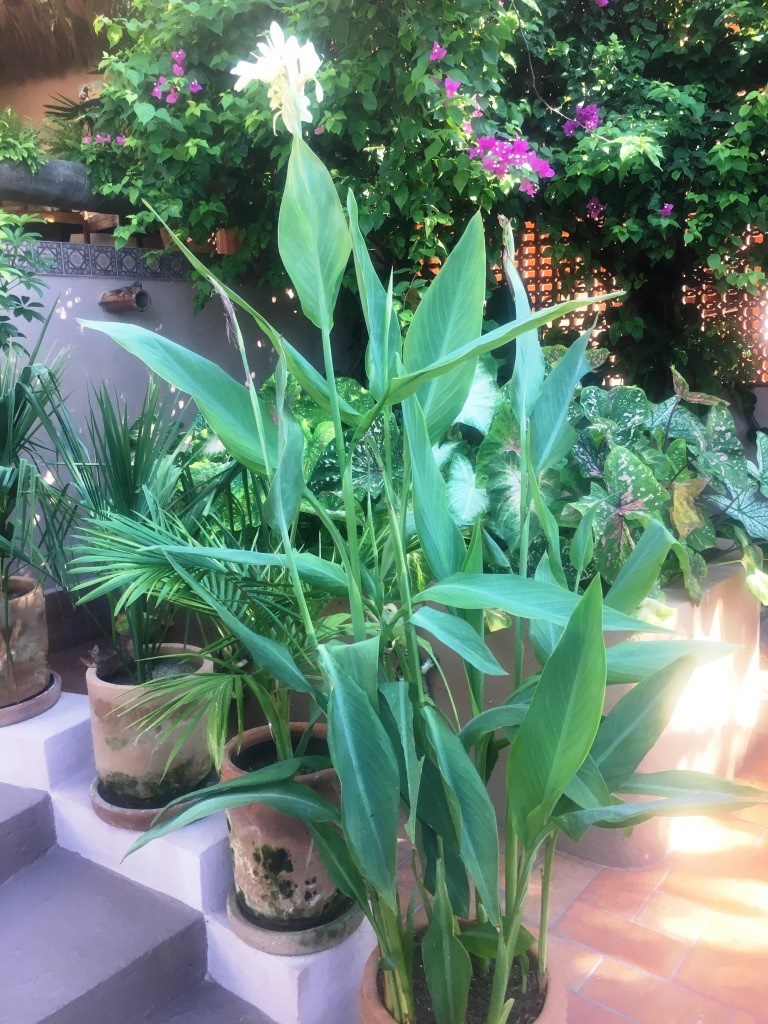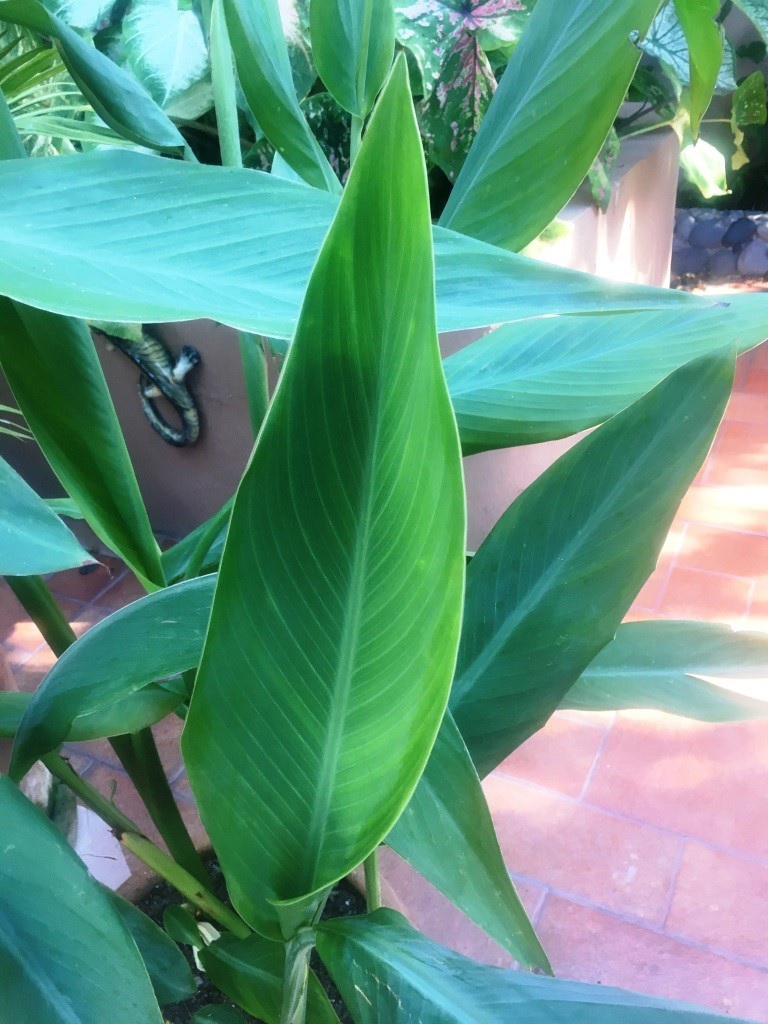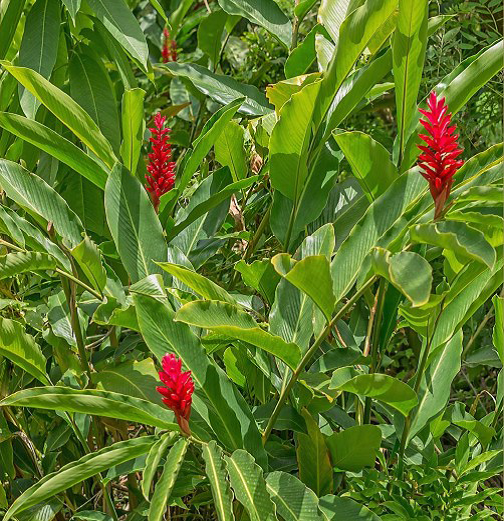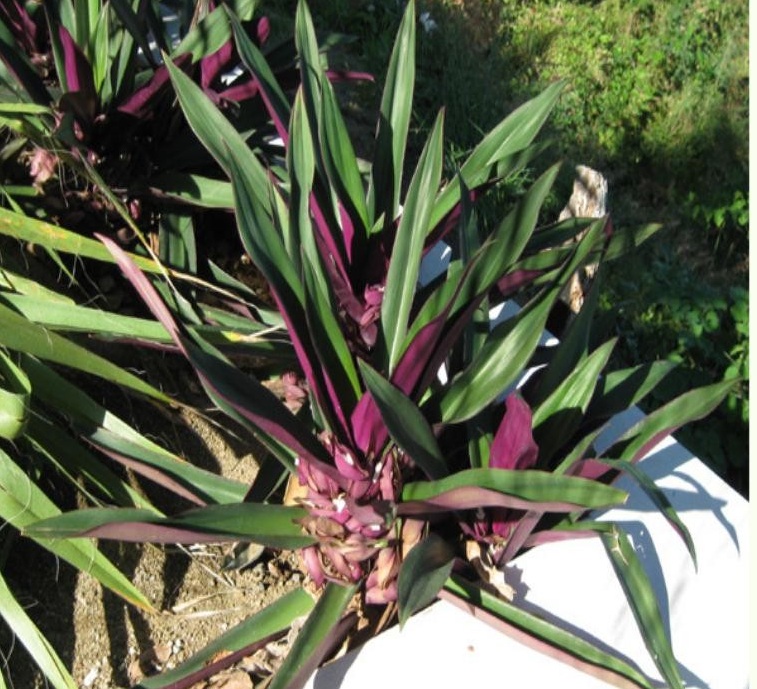By Tommy Clarkson on the January 2020 Edition
Yellow Ginger Hedychium flavescens
Family Zingiberaceae
Also known as Yellow Ginger-Lily, Cream Garland-Lily or Cream Ginger
Walking through our gardens this morning, I pondered about which of my tropical plant family I should next write. As I do every time I walk down into them, I strolled past my potted Yellow Ginger on the Transition Terrace with its somewhat butterflyshaped flowers. I was several steps beyond it when I asked myself, when I had written about this attractive mainstay long a part of the beauty that constitutes Ola Brisa Gardens. Lo and behold, I realized, I never had . . . and fast discerned that a surprising few other tropical plant writers had as well! So, based on personal experience, supported by a few others, here we go.
I learned from Kirsten Albrecht Llamas’ book “Tropical Flowering Plants” that the Yellow Ginger originated in northeastern India and Nepal. She and other botanical purists describe the Hedychium flavescens as a “perennial rhizomatous herb.” In bright, filtered light, they grow to between six to ten feet (1.83 – 3.04 meters) preferring organically rich, well-draining soil. Seasonal, they will commence blooming with cooling evening temperatures. Depending upon one’s plant, atop two-foot (.61 meter) long leaves, those beautiful, somewhat upright, elliptic lip shaped blooms may range from a pale to creamy yellow.

Graeme Teague, in his book, “Tropical and Garden Flower Identification,” informs us that “The genus name derives from two ancient Greek words, hedys meaning “sweet” and chios meaning “snow.” He also says that “Hedychiums are more cold hardy than most gingers, and are often called Hardy Ginger Lily.” As an interesting aside, it may be worthy of noting that Sterling Macoboy, in “Tropical Flowers and Plants,” shares that “The related Kahili Ginger (Hedychium gardnerianum) is . . . (even) more spectacular, producing eighteen inch spikes of scarlet and yellow blossoms.” However, it is poisonous to animals, and can be fatal if enough of the plant is ingested.
Interestingly, one of the best and most complete descriptions of this plant was found online on the Philippine Medicinal Plants site, which said, and in this case I am not going to con-vert measurements from metric to standard, but may post a few botanical term definitions: “Hedychium flavescens is a ro-bust perennial herbaceous herb with leafy shoots growing 1 to 3 meters high. Rhizomes are large and branching, thick and fleshy, up to 3.5 centimeters in diameter. Leaves are stiff, green sessile [attached directly by its base], oblong to lanceolate, up to 60 centimeters long, and 12 centimeters wide. Flowers are fragrant, inflorescences erect, up to 20 centimeters long, 8 centimeters wide, loosely imbricate [arranged so as to allow over-lapping, like roof tiles] with a yellowish corolla, and staminodal [a sterile or abortive stamen, frequently resembling a stamen without its anther tip] that is obcordate [heart shaped], claw-like, reddish yellow at base. Fruits are globular capsules with three valves, containing many seeds.”

It goes on to elaborate that, its “oil has shown central nervous system tranquilizing effects and anthelmintic activities (with) studies (having) shown antiproliferative, antibacterial, antifungal, mosquito repellent properties.” Beyond that, its “young buds and flowers are eaten or used as flavoring.”
As to folkloric medicinal uses, “In the Philippines, the base of the stem (is) chewed or drunk as decoction for tonsillitis. In the Moluccas, juice from the stem (is) applied as a remedy for swellings. In Comoros, Africa, crushed rhizomes (are) used to treat fractures. In India, rhizomes (are) used by tribal groups of Bijar as (a) febrifuge, antirheumatic, tonic and stimulant.
In Manipur, India, rhizomes (are) used for treatment of various skin infections. A boiled extract of rhizome with salt (is) used as (a) gargle for throat swellings and also taken orally for abdominal swellings, colic and hemorrhoids. Crushed extract of fresh rhizome (is) used with honey for chest congestion, cough, asthma, and bronchitis.”
As a nice addition to your garden, maintenance is minimal. One of your biggest chores will be to simply cut back the canes when they start to yellow. Most species can handle full, bright sun, but the flora will remain attractive longer in filtered light.
Other places much more than that is required inasmuch as, for instance, in New Zealand, it is considered an invasive weed!
Within the Hedycium genuscommonly called Ginger Lilies are around fifty different species all from Southeastern Asia and Indomalaysia.
Some have fragrant flowers from which oil is extracted for making perfume. However, sadly, ours does not. (Might one say that ours has no “common scents?”)
The full edition or view it online
—
Tommy Clarkson is a bit of a renaissance man. He’s lived and worked in locales as disparate as the 1.2 square mile island of Kwajalein to war-torn Iraq, from aboard he and Patty’s boat berthed out of Sea Bright, NJ to Thailand, Germany, Hawaii and Viet Nam; He’s taught classes and courses on creative writing and mass communications from the elementary grades to graduate level; He’s spoken to a wide array of meetings, conferences and assemblages on topics as varied as Buddhism, strategic marketing and tropical plants; In the latter category he and Patty’s recently book, “The Civilized Jungle” – written for the lay gardener – has been heralded as “the best tropical plant book in the last ten years”; And, according to Trip Advisor, their spectacular tropical creation – Ola Brisa Gardens – is the “Number One Tour destination in Manzanillo”.



